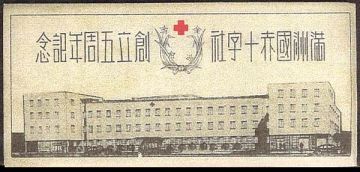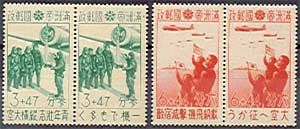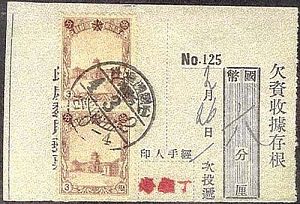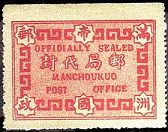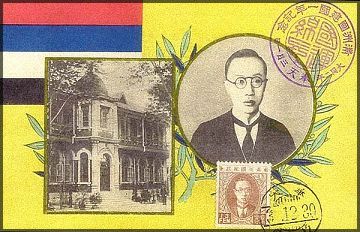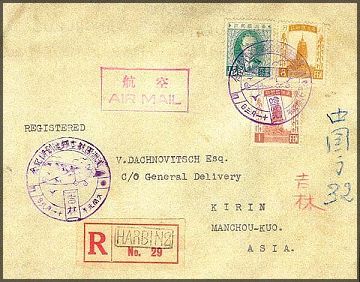Manchoukuo was the subject of my first Linn's Asia column, in the May 22, 1989, issue - a little more than 10 years ago.
That article was your basic Manchoukuo roadmap.
The recent reviewing of a wonderful Manchoukuo collection reminded me how much fun collecting this Japanese puppet state can be. With no lack of fascinating tangents to pursue and little expensive material to hinder forming a comprehensive collection, all one needs is the curiosity to get started.
Manchoukuo's first regular issue of 18 values, Scott 1-18, was released on July 26, 1932, not long after the quasi-independent state was created by Japan in northeastern China.
As is common for lithographed definitive stamps, numerous constant varieties exist. As the stamp printings progressed on these issues, the quality of these impressions ranged from clear to worn.
For the same reason, shade varieties can also be found.
A 14-character imprint appears on the selvage of all values for the first printing of 2000 sheets. These imprints are quite scarce.
Chinese General Su Ping-wen challenged Manchoukuo's legitimacy, capturing and overprinting several values of the first issue. Counterfeits of these overprinted issues abound, on and off cover. They can be quite deceptive, so authentication is difficult.
The two commemorative sets of 1933 and 1934 (Scott 19-22 and 32-5), originally in sheets of 100, were reprinted as miniature sheets of 20 stamps each. These reprints are scare and valuable.
Provisional stamps are created to give a new postage value to a stamp that is already printed. This is done by adding an overprint called a "surcharge".
What makes the 1934-5 provisional issues (36, 36a, 59-61) so interesting are the various types of character fonts or typefaces used for surcharging. Instead of selecting just a single stamp of each issue, adventurous collectors try for se-tenant strips of stamps that show varying fonts.
The 1-fen-on-4f provisional is found with the black surcharge (36) and the far scarcer brown variety (36a). These exist in four types. What variety specialists refer to as Type D is found but once per sheet of 100.
The different surcharge types are listed and described in an excellent book by Helen K. Zirkle, The Postage Stamps and Commemorative Cancellations of Manchoukuo, published in 1964 by the Collectors Club of New York.
The 1935 3-f-on-4-f provisional shows the overprint applied to stamps on both unwatermarked (59) and watermarked (60) paper. There are three font types of which types B and C are truly rare, with only one each per sheet.
Look for the upper right corner block of 1935's 3f-on-16f Pu Yi issue (61). This rare positional block is prized because it contains one each of all four surcharge types. The scarce Type D is found only once more in the sheet.
Each of the six booklet panes issued by the Government is listed in the Scott Standard Postage Stamp Catalogue.
One can find the 1937 booklet panes (86a and 88a) easily enough, but the 1936 panes (85a and 87a) are tough. Intact postally-used panes are understandably rare.
The 2f and 4f 1937 panes are found in three types. These are also the easiest to find in complete booklets.
The 1935 Tokyo Visit set (71-74) is another intriguing issue, as again there are many varieties. All values exist perforated incorrectly: either imperforate between the stamp and the margin, imperforate between stamps, or with compound perforations. The placement of rogue 12¼- and 12½-gauge perforation rows makes for interesting combinations with the usual perforation gauge of 11.
The Tokyo Visit set is most often found tied to fancy commemorative and patriotic postcards by violet first-day postmarks.
Specialists relish the 1936-7 definitive set, as interesting possibilities abound. Imperforates of several low face values are said to be printer's waste smuggled out the back door.
I've seen the occasional cover with an imperforate pair tied (meaning, the single postmark strikes both the affixed stamps and the cover). Whatever the official status of these varieties, they are rare and highly prized.
If you were told that only 100 examples were ever found of any single error, as it is on the 2½f-on-2f inverted surcharge (105a), surely you would think that it would sell for more than $150. The low price is advantageous, and few of the really rare pieces you might want for your collection are expensive.
China declared Manchoukuo postage stamps illegal, blackening out the characters for "Manchoukuo" on whatever stamps were used on letters mailed to China. In accordance with the Sino-Manchoukuo Postal Agreement of December 1934, four "China Mail" sets were issued in which Manchoukuo's name was omitted. These are listed as Scott 62-5, 66-70, 75-8, 113-5.
I've seen a heavily toned imperforate pair of the 1937 5f (113). This rarity isn't mentioned in any of the literature. Often we see the common 1944 5f imperforate, but that issue is on unwatermarked paper whereas the 1937 variety is watermarked.
While first-day covers can be had from the first issues on, those of 1938-45 are far more common and are each priced in the $10-16 range.
The careful collector knows that the 1938 issues onward have many varieties. As trained technicians became scarcer, the quality of the printing suffered, and we can find many plate deficiencies.
Figure 1. Manchoukuo's 1943 Red Cross Nurse presentation booklet.
The cover depicts Hsingking Central Hospital.
Red Cross collectors vie for the rare privately-prepared 1943 presentation booklet containing four panes of 20 of the green 6f Red Cross Nurse (152). This beautiful illustrated booklet shows the Hsingking Central Hospital on the front and appropriate inscriptions on the reverse.
The front cover of the booklet is illustrated in Figure 1.
"Japan's Progress is Manchoukuo's Progress" is the subject of two se-tenant pairs of 10f and 40f values issued in 1944. Both values are found imperforate.
The 40f exists with a rounded corner frame variety that is similar to the frame normally found on the 10f. This, too, can be located imperforate.
The 40f can also be found occasionally with a sloping "4". It is said that this errant plate was made later than the rest.
Manchoukuo's most evocative stamps weren't actually issued at all. Se-tenant pairs of the 3f+47f and 6f+44f semipostal stamps were announced in 1941, printed in 1944, and scheduled to be issued in September 1945.
Figure 2. Manchoukuo planned to issue these setenant semipostal stamps
in 1945, but they were never released.
As the Japanese surrendered in August 1945 and control of the area was returned to China, these stamps were not issued. Only later did two or three sheets of each issue reach the philatelic marketplace. Examples of both pairs of unissued stamps are shown in Figure 2.
The patriotic inscription at the bottom of the design alternates between Japanese and Chinese, creating the se-tenant variety. The 3f+47f reads "Spirit of Youth Conquers the Sky," and the 6f+44f says, "Dedicate Planes and Crush the Dreaded Enemy."
Figure 3. To account for postage due, normal stamps of Manchoukuo
were postmarked on piece as a receipt.
Instead of postage due stamps, Manchoukuo's postal officials postmarked normal stamps on piece and used them as a receipt for collected money, as shown in the stamps pictured in Figure 3.
Manchoukuo's postal stationery consists of many postal cards and letter cards. The cards are found with many different inscriptions. Some cards bear images of scenery imprinted on one side.
Officially Sealed labels are printed in carmine. I do not know the sheet size, but I do know that stamps from along the edges of the sheet are imperforate on that side. Many collectors seek one imperforate from each side plus one perforated all around.
Figure 4. Manchoukuo Officially Sealed labels can be found with a
misspelling of the word "OFFICIALLY" as "OFFIOALLY".
There's a visually appealing error, shown in Figure 4: the label is inscribed "OFFIOALLY" instead of "OFFICIALLY".
Eighty-five commemorative cancellations are described in full and illustrated in the Zirkle book.
These start with one cancel from September 1932 commemorating the start of hostilities in Manchuria. The last one Zirkle describes is dated July 3, 1944, for Aid to Soldiers.
Figure 5. Manchoukuo's propaganda postmarks are often found
canceled-to-order on postal cards.
These handsome propaganda postmarks are often found used canceled-to-order on postal cards, as shown by the card pictured in Figure 5.
Each issued stamp set has its own commemorative postmark.
Figure 6. Postal history items, such as this registered mail piece,
provide collectors an opportunity for advanced study.
Postal history collectors are rewarded by much variety. Covers sent through the mail, such as the registered-mail example pictured in Figure 6, offer much to study, including the application of appropriate rates.
Manchoukuo had a population of 42 million. Mail arriving into China offers a wide field to study. Even though Manchoukuo was not a member of the Universal Postal Union, its mail was accepted worldwide without many problems.
Several thousand stamps with local overprints can also be found, created just after Japan surrendered. The Communists took over North China, and these locals were hastily prepared in order to fill the gap before new stamps could be issued. Called Manchurian local overprints (MLO), these are best recorded and organized in Allen Kerr's four-volume out-of-print reference, Local Overprinted Stamps of Manchuria.
Several excellent handbooks have been published to aid the Manchoukuo collector. Besides the Zirkle previously mentioned, works by Roy Akagi, J. Haag-Pedersen, A. Schumann, and W. Horney are notable. Articles in The American Philatelist, the China Stamp Society's journal China Clipper, and the International Society of Japanese Philately's journal Japanese Philately also cover the subject well. Robert M. Spaulding, Jr. wrote a classic handbook on Manchoukuo postal stationery. Copies occasionally turn up in specialist auctions.
Whether known as Manchoukuo, Manshkoku, Manchoutikuo, or just Manchuria, this is a wide-open, wonderful area to pursue.
I'd be happy to send a copy of my 1989 Manchoukuo article to anyone sending a 33¢ addressed, stamped envelope to us in care of Linn's. Box 29, Sidney, OH 45365. I'll also include a membership application for the International Society of Japanese Philately.
